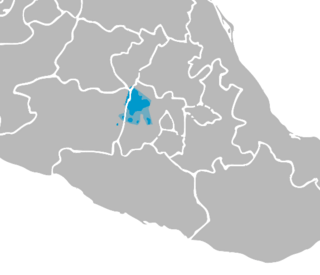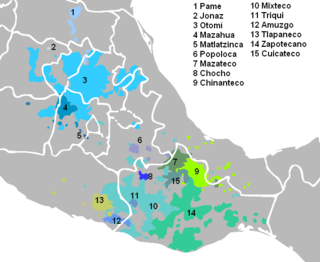Our website is made possible by displaying online advertisements to our visitors.
Please consider supporting us by disabling your ad blocker.
Mazahua language
| Mazahua | |
|---|---|
| Jñatjo (Toluca Mazahua) Jñatrjo (Central Mazahua) | |
| Pronunciation | [ɲ̥atrjo] |
| Native to | Mexico |
| Region | State of Mexico, Toluca |
| Ethnicity | Mazahua |
Native speakers | 150,000 (2020 census)[1] |
Oto-Manguean
| |
| Official status | |
| Regulated by | Secretaría de Educación Pública |
| Language codes | |
| ISO 639-3 | Either:mmc – Toluca Mazahuamaz – Central Mazahua |
| Glottolog | maza1293 |
 Extent of the Mazahua language in Mexico | |
 The Mazahua language, number 4 (darker blue), northwest | |
The Mazahua language (Central Mazahua: Jñatrjo, [ɲ̥atrjo]) is an Oto-Pamean language spoken in the central states of Mexico by the ethnic group that is widely known as the Mazahua but calls itself the Hñatho. It is a Mesoamerican language and has many of the traits of the Mesoamerican Linguistic Area. In 2003, along with some 62 other indigenous languages, it was recognised by a statutory law of Mexico (General Law of Linguistic Rights of the Indigenous Peoples)[2] as an official language in the Federal District and the other administrative divisions in which it is spoken, and on an equal footing with Spanish. The largest concentration of Mazahua is found in the municipality of San Felipe del Progreso, State of México, near Toluca.
The closest relatives of the Mazahua language are Otomi, Matlatzinca, and Ocuilteco/Tlahuica languages, which together with Mazahua form the Otomian subgroup of the Oto-Pamean branch of the Oto-Manguean language family.
Mazahua is a tonal language and distinguishes high, low, and falling tones on all syllables except the final syllable of a word whose stress is predictable.
Mazahua's most distinctive feature is its abnormally-large phoneme inventory, around sixty phonemes, or twice the number in English. There are eight vowel phonemes, seven contrastive nasal vowels, and as many as forty-five consonants.
Amongst them are ejectives, implosives and contrastive voiceless sonorants. Along with Sindhi and Tukang Besi, Mazahua is a rare case of a language with true implosives that is far from regions where implosives are commonly encountered. It is also one of the few languages with ejective fricatives.[3]
Mazahua-language programming is carried by the CDI's radio station XETUMI-AM, broadcasting from Tuxpan, Michoacán.
- ^ INALI (2012) México: Lenguas indígenas nacionales
- ^ "Ley General de Derechos Lingüísticos de los Pueblos Indígenas" [General Law of the Linguistic Rights of Indigenous peoples] (in Spanish). 13 March 2003. Archived from the original on 8 February 2007.
- ^ Ian Maddieson (with a chapter contributed by Sandra Ferrari Disner); Patterns of sounds; Cambridge University Press, 1984. ISBN 0-521-26536-3
Previous Page Next Page


